HNL Round 12 Recap: Osijek Topped Dinamo, Hajduk Better than Belupo
November 23, 2020 - The 12th round of the Croatian First League was held from November 20 to 21, 2020. In this round, Osijek topped Dinamo 2:0, and Hajduk won away at Belupo.
Lokomotiva v. Varazdin (2:2)
Lokomotiva and Varazdin opened the 12th round on Friday, November 20, 2020, in Zagreb.
Delic scored the first goal for Varazdin in the 7th minute, though Chajia was quick to equalize for Lokomotiva with a goal three minutes later for 1:1. An own goal by Hendija gave Varazdin the 1:2 lead in the 60th, but a last-minute equalizer by Papadopoulos ended the game 2:2.
Lokomotiva is currently in 8th place with 8 points, while Varazdin is in 9th with 8.
Sibenik v. Gorica (1:3)
Sibenik and Gorica met for the second match on Friday, November 20, 2020, in Sibenik.
While Ampem gave Sibenik the lead in the 7th minute and through the first half, Gorica woke up in the second and scored all three of their goals - Cabraja in the 62nd, Suk in the 81st, and Lovric in the 3rd minute of added time.
Sibenik is currently in 6th place with 13 points, while Gorica is in 3rd with 19.
Osijek v. Dinamo (2:0)
Osijek and Dinamo met on Saturday, November 21, 2020, at City Garden Stadium.
While the first half went without goals, Osijek's Pilj gave the home team the lead in the 54th minute, and Zaper increased their lead to 2:0 in the 89th for the final score of the match.
Osijek is currently in 2nd place with 23 points, while Dinamo is in first with 26.
Slaven Belupo v. Hajduk (0:2)
Belupo and Hajduk closed out the 12th round on Saturday, November 21, 2020, in Koprivnica.
Hajduk Nayir scored the first goal of the match just before the half for 0:1. An own goal by Soldo increased Hajduk's lead to 0:2 in the 56th minute, which was the final result.
Belupo is currently in 7th place with 11 points, while Hajduk is in 5th with 14.
At the request of Rijeka, which counted seven footballers positive for coronavirus, the Croatian Football Federation postponed their 12th round match against Istria 1961, which was to be played on Saturday, November 21, in Pula.
See the full HNL table HERE.
To read more about sport in Croatia, follow TCN's dedicated page.
HNL Round 11 Recap: Hajduk and Osijek Draw at Poljud, Dinamo Crush Istria 5:0
November 9, 2020 - The 11th round of the Croatian First League was held from November 7 to 8, 2020. This round saw Hajduk and Osijek draw at Poljud, while Dinamo toppled Istra 5:0.
Varazdin v. Sibenik (1:3)
Varazdin and Sibenik opened the 11th round on Saturday, November 7, 2020, in Varazdin.
Juric scored two goals for Sibenik in the first half (8', 26') for 0:2 at the half. A hattrick in the 57th minute made Juric the hero of the game. Varazdin's Benko slightly reduced Sibenik's lead with a goal in the 70th minute for the final result of 1:3.
Varazdin is currently in last place with 7 points, while Sibenik is in 5th place with 13.
Hajduk v. Osijek (1:1)
Hajduk and Osijek met in the second match on Saturday, November 7, 2020, at Poljud stadium in Split.
Osijek took the lead in the 23rd minute thanks to a goal by Mierez for 0:1 at the half. Hajduk's Colina equalized for 1:1 in the 55th minute. Hajduk missed a last-minute penalty, resulting in a 1:1 draw.
Hajduk is currently in 7th place with 11 points, while Osijek is in 2nd place with 20.
Dinamo v. Istra 1961 (5:0)
Dinamo and Istra met at Maksimir stadium in Zagreb on Sunday, November 8, 2020.
Gavranovic opened the scoring spree for Dinamo in the 6th minute, followed by a Jakic goal just before the half for 2:0. Gavranovic scored again in the 75th minute, followed by another quick goal one minute later by Orsic for 4:0 in the 76th minute. Tolic secured Dinamo's 5:0 victory with the final goal in the 87th minute.
Dinamo is currently in first place with 26 points, while Istra is in 8th with 8.
Rijeka v. Lokomotiva (1:0)
Rijeka and Lokomotiva closed out the 11th round on Sunday, November 8, 2020, at Rujevica stadium.
Muric scored the only goal of the match, which happened in the 17th minute from a penalty to give Rijeka the win.
Rijeka is currently in 4th place with 15 points, while Lokomotiva is in 9th with 7.
Recall, Gorica was supposed to host Slaven Belupo on Sunday, November 8, at 19:10, though the match was postponed again due to COVID-19.
Several members of the Koprivnica first league squad tested positive, including players and members of the professional staff, so the entire team was ordered by the competent epidemiologist to go into self-isolation until Thursday, November 12.
Gorica thus did not play for the third round in a row, as their previous two matches were also postponed (against Rijeka and Varazdin) because of COVID-19.
You can see the full HNL table here.
To read more about sport in Croatia, follow TCN's dedicated page.
EHF Cup: Croatia Men's Handball Team Top Hungary in Osijek
November 8, 2020 - In its first appearance in the EHF Cup in Osijek, the Croatia men's handball team defeated Hungary 31-27 (17-13).
Since the World Handball Championship will be held in Egypt from January 13 to 31, 2021, these matches serve as good preparation for the big competition ahead.
It was the first game for the Croatian 'Cowboys' in nine months when they won silver at the European Championships in Sweden. Coach Lino Cervar could not count on about 10 standard national team members due to the coronavirus pandemic.
Despite that, Croatia led throughout the match, and with a 5-1 series at the end of the first half, they turned an 8-9 deficit into a 13-10 advantage and went into halftime with 17-13. Still, Hungary opened the second half better and leveled the score at 18-18, but did not take the lead. In the last 10 minutes, Croatia led 25-24, and goalkeeper Sego stood out with three stellar saves, one of which was off a seven-meter shot. Croatia then managed to lead 28-25.
Manuel Strlek and Ivan Martinovic scored six goals each for Croatia, Domagoj Duvnjak added five goals, while the most efficient for Hungary was Richard Bodo with six goals.
After the great victory against Hungary, coach Lino Cervar commented on the match.
“After 10 months, the players showed a connection to the national team jersey. They came from all over Europe to play, risking getting sick, so hats off to our national team, the players who came here. I am also satisfied with the victory; of course, it is a victorious path that we continue from Stockholm. The players prepared differently since there were breaks. Therefore, such a situation was more for us to endure in such difficult conditions and without spectators, which I am upset about. What should be pointed out today is that they showed a desire to win."
With this victory, Croatia took the lead in the EHF Cup with two points from one match. Hungary, which played two matches, has the same number of points, while Slovakia, who did not play a single match, and Spain, who played one, have no points.
Croatia should play the next game in the EHF Cup on January 6 against Spain away, and only three days later, they should host the same opponent at home.
Source: Gol.hr
To read more about sport in Croatia, follow TCN's dedicated page.
The Country's Biggest Export... Croatian Chocolate!?!
November 4, 2020 - Olive groves and vineyards are iconic elements of the vista on the Croatian coast. They appear frequently, as does the international recognition for the wine and olive oil they produce. This makes it all the more surprising to learn that the country's biggest export is, in fact, Croatian chocolate.
On 4 November 2020, 24 Sata reported the surprising statistics about Croatian chocolate. Their sources are agricultural and food product reports from 2018 and 2019, made by the Croatian Chamber of Commerce. They state that Croatian chocolate and cocoa products were at the top of the export rankings. Croatia wine and Croatia olive oil didn't even get a look-in the top five Croatian exports – the next biggest were corn, tobacco products and then fresh and frozen fish. © Alexander Stein
© Alexander Stein
The production of wine and olive oil in Croatia goes back many thousands of years. The industry for making Croatian chocolate is a baby in comparison – Europeans only encountered cacao beans in the 16th century, while exploring and colonising the Americas. Still, the production of Croatian chocolate does have quite a history.
Bajadera by Zagreb's Kraš is one of the most popular boxes of Croatian chocolate to be given as a gift © Kraš
The oldest maker of Croatian chocolate is Zagreb's Kraš. The company's roots lie in three confectioners from the early 20th century. Union is the oldest chocolate manufacturer in south-east Europe (just two years after its foundation in 1911 was awarded the title of supplier to the royal court in Vienna and Budapest), Karolina, a former flour mill which switched to making biscuits and waffles in 1921 and Bizjak, founded in 1923, which made cookies and wafers. These companies, along with a number of smaller Zagreb confectionery manufacturers were merged in 1950 under the name of Kraš, in honor of Josip Kraš, a Croatian union leader and anti-fascist who was killed in World War II. Their range today includes the bars Dorina and Animal Kingdom, boxed classic Bajadera, chocolate biscuits Domaćica and the wafer bars Napolitanke and Tortica. Kandit's classic Rum bar, made in Osijek. Hands-down the best ultra-cheap Croatian chocolate mini-snack bar © Kandit
Kandit's classic Rum bar, made in Osijek. Hands-down the best ultra-cheap Croatian chocolate mini-snack bar © Kandit
The second oldest company making Croatian chocolate is Kandit, which is today still based in Osijek where its parent company was established way back in 1905 as a sugar production outfit. It switched to making waffles, sweets and chocolates in the early 1920s. Its range today includes the kids' favourite Choco Banana and hands-down the best ultra-cheap Croatian chocolate mini-snack bar Rum. It's a classic. Keeping on-trend, the relatively recent No Guilt series of high-quality, no-sugar chocolate bars has made a great addition to Kandit's offer. This range is the only Croatian chocolate currently recommended by the country's diabetic association. Kandit's No Guilt range has no added sugar and several bars with a high cacao content © Kandit
Kandit's No Guilt range has no added sugar and several bars with a high cacao content © Kandit
The third big player in the Croatian chocolate scene is Zvečevo, from Požega. The company traces its roots back to 1921, but its association with chocolate only really began in 1934 when Swiss company Nestle began to manufacture there (the association continued until 1995). Zvečevo is notable as having invented the combination of toasted rice and milk chocolate in a bar. Now considered a classics pairing across the world, it was first produced in 1964 in Požega under the name of the Mikado bar. As well as still making this classic of Croatian chocolate, Zvečevo now makes a dark chocolate version, chocolate for use in home cooking and a popular range of strong alcoholic drinks. It has won several awards for its ethical and eco-friendly business practices. Zvečevo's Mikado range. With Mikado, the Požega-based manufacturers were the first in the world to combine rice and chocolate © Zvečevo
Zvečevo's Mikado range. With Mikado, the Požega-based manufacturers were the first in the world to combine rice and chocolate © Zvečevo
Standard Croatian chocolate available on the high street can be a surprise to visitors. It has a higher content of the cheaper ingredient (sugar) than the more expensive ingredient (cacao) than many chocolates made in more westerly European countries. But, that's the way Croatians seem to like their chocolate. Well, most of them. According to a survey conducted in 2017 by the Hendal agency and JaTRGOVAC magazine, 63.5% of asked Croatians said they choose domestic chocolate products above the 36.5% who more often buy foreign chocolate products. © Nawal Escape
© Nawal Escape
Data from the Central Bureau of Statistics state that in 2018 the country produced 18,799 tons of Croatian chocolate and cocoa products. Over 800 million kuna's worth of Croatian chocolate was exported in the same year. The bond between Croats and their Croatian chocolate is strong, the love heartfelt. It is no doubt this affection for confection that has prompted some of the third of Croats who go in search of foreign alternatives, for the introduction of premium chocolate ranges by the aforementioned big manufacturers of Croatian chocolate and for the rapid increase in artisan and handmade Croatian chocolatiers over recent years.
Croatian chocolate smaller and artisan producers
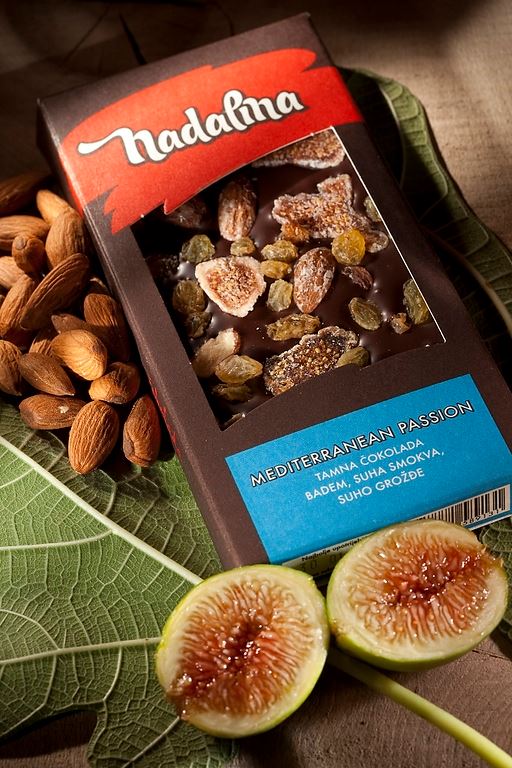
Split-based Nadalina have become increasingly recognised over recent years © Nadalina
Split-based Nadalina make high-quality raw chocolate bars with non-standard flavours like rosemary, figs and olive oil. They held the Guinness World Record for making the world’s largest chocolate bar and in 2017 were voted the world's third-best at the International Chocolate Awards. Vilma slastice from the island of Rab combine dark chocolate with flavours like Pag cheese, white truffles and lavender. Salt manufacturers Solana Nin have a salt-infused chocolate and Zagreb's Chozen make impossibly-pretty handmade Croatian chocolate pralines with a surprising and adventurous range of flavours. Besides these, the list of small manufacturers of Croatian chocolate grows every year. It seems that the love affair between Croats and their chocolate is far from finished, and that's certainly good news for Croatian exports. Impossibly pretty handmade chocolate truffles, produced in Zagreb by Chozen © Chozen
Impossibly pretty handmade chocolate truffles, produced in Zagreb by Chozen © Chozen
For the latest travel info, bookmark our main travel info article, which is updated daily.
Read the Croatian Travel Update in your language - now available in 24 languages
Three 9th Round Croatian First League Matches Postponed due to COVID-19
October 22, 2020 - As COVID-19 rips through Croatia, three 9th round Croatian First League matches meant to be played this weekend have been postponed.
It all began yesterday when Lokomotiva Zagreb announced they still cannot compete as the coronavirus has penetrated its dressing room. After postponing the match against Osijek last weekend, the 9th round match against Hajduk, which was supposed to be played on October 24, at Kranjčevićeva, is also postponed. The match will take place on the first possible date, which will be decided later.
The Croatian Football Federation stated the following explanation:
"On October 21, 2020, NK Lokomotiva submitted a notification that four players tested positive for coronavirus after testing the entire team, and two more have an epidemiological measure of self-isolation. Therefore, NK Lokomotiva cannot continue the regular competition and requests the postponement of the 9th round match in the HT First League between Lokomotiva - Hajduk.
Following the regulations of the HNS and the decision of the Competition Commission of the HNS from the session held on August 6, 2020, which authorizes the commissioners of the competition to postpone a particular match in case there are six or more players of the same club in self-isolation; based on the request of NK Lokomotiva, a decision was made to postpone the match. According to the provisions of the Rules on Football Competitions and the Propositions of Competitions, postponed matches must be played in the first possible free period, on which a decision will be made later."
Furthermore, Gorica announced today that five players have tested positive for coronavirus, so the match supposed to be played against Rijeka on Sunday has also been postponed.
"The 9th round of the HT First League, which was supposed to be played at the City Stadium in Velika Gorica, was postponed because the results of individual testing confirmed coronavirus infection in five HNK Gorica players, and three more have a prescribed measure of self-isolation.
Based on the request of HNK Gorica, following the regulations of HNS and the decision of the Competition Commission of HNS, a decision was made to postpone the match."
But that's not all.
After the Gorica-Rijeka match was postponed, the same happened with the match between Istria and Osijek.
"The match between Istra 1961 and Osijek is postponed.
The test results confirmed the coronavirus in seven players of the Osijek Football Club. To avoid spreading the infection further, it is necessary to postpone the match until the competent epidemiologists decide on further action."
You can see the Croatian First League table HERE.
To read more about sport in Croatia, follow TCN's dedicated page.
HNL Round 8 Recap: Shocking Hajduk Loss to Sibenik, Osijek-Lokomotiva Postponed
October 19, 2020 - The 8th round of the Croatian First League was held from October 16 to 18, 2020. This round featured a shocking Hajduk loss to Sibenik, while Osijek and Lokomotiva has been postponed due to coronavirus cases in the Zagreb club.
Slaven Belupo v. Istra 1961 (5:1)
Belupo and Istra opened the 8th round on Friday, October 16, 2020, in Koprivnica in front of 308 spectators.
Belupo's scoring spree started in the first half with two goals by Bozic in the 31st and 45+2 minutes for 2:0 at the half.
Krstanovic (penalty) and Glavic increased Belupo's lead in the 50th and 61st minutes for 4:0. Boakye made it 5:0 in the 79th minute, though Istra's Vuk was able to come back to score one goal in the 85th minute for the final score of 5:1.
Belupo is currently in 6th place with 7 points, while Istra is in the last place with 5.
Dinamo v. Gorica (3:2)
Dinamo and Gorica met on Saturday, October 17, 2020, at Maksimir Stadium in front of 815 spectators.
Gavranovic scored two goals for Dinamo in the 32nd and 36th minutes for 2:0 at the half. Gorica opened the second half with two goals to equalize - Mudrinski scored in the 46th and Hamad in the 50th for 2:2.
Gavranovic secured a hattrick with a goal in the 66th minute for 3:2, which was the final score of the game.
Dinamo is currently in first place with 19 points, while Gorica is in 2nd with 16.
Rijeka v. Varazdin (2:1)
Rijeka and Varazdin met on Saturday, October 17, 2020, at Rujevica Stadium in front of 2,072 spectators.
While Varazdin's Obregon was the first to score in the 17th minute for 0:1, an own goal by Stolnik made it 1:1 three minutes later. Kulenovic then increased Rijeka's lead to 2:1 at the half.
With no goals in the second half, the game ended at 2:1 for Rijeka.
Rijeka is currently in 4th place with 12 points, while Varazdin is in 8th place with 7.
Hajduk v. Sibenik (0:1)
Hajduk and Sibenik met at Poljud Stadium on Sunday, October 18, 2020, in front of 4,517 spectators.
Sahiti scored the only goal of the game in the 34th minute, which gave Sibenik the victory.
Hajduk is currently in 5th place with 10 points, while Sibenik is in 7th with 7.
Osijek v. Lokomotiva (POSTPONED)
Two players of NK Lokomotiva are positive for coronavirus, the Zagreb club announced on Sunday.
"Two NK Lokomotiva players were tested for COVID-19 on Sunday, October 18, and are positive. According to the Personal Data Protection Act (GDPR), we are not able to disclose the identity of the infected persons," the statement said on the club's website. The club also announced that "the competent epidemiological service was immediately notified, which imposed a measure of strict self-isolation on the two players, all following the recommendations of the Croatian Civil Protection Headquarters and the HNS working group."
Lokomotiva was supposed to play against Osijek Sunday at 5:05 pm, but the match was postponed.
"To avoid further possible spread of the infection to all other participants in the Osijek - Lokomotiva match, it is necessary to postpone it until the competent epidemiologist decides on further action and until additional testing of the entire team and determine the actual situation. According to the provisions of the Ordinance on football competitions and the Proposition of the competition, postponed matches must be played in the first possible free term, which will be decided later," said the commissioner of HT Prva Liga, Josip Brezni.
You can see the full HNL table here.
To read more about sport in Croatia, follow TCN's dedicated page.
Programme Against Food Waste to be Implemented in Osijek Schools
ZAGREB, October 17, 2020 - A Croatian member of the European Parliament, Social Democrat Biljana Borzan, on Saturday presented a programme against food wasting, to be implemented in 46 kindergartens and schools in Osijek in cooperation with the UN Food and Agriculture Organisation (FAO).
Borzan told a news conference that Osijek was the first Croatian city to join this project, which is already being implemented in Italy, France, Belgium and the UK.
She recalled that at the time when she drafted a report on the issue of food waste for the EP, she was apporached by FAO with a proposal to help it find partners in Croatia.
Osijek was the first to accept the initiative and it will be the first city in Croatia to implement the programme against food waste in its educational institutions.
Osijek Deputy Mayor Boris Pilizota said that around 1,000 tonnes of food are wasted in Croatia daily, while in the EU 90 million tonnes of food are wasted per year.
HNL Round 7 Recap: Gorica Topped Hajduk, Osijek Moved into 3rd
October 5, 2020 - The 7th round of the Croatian First League was held from October 2 to 4, 2020. In this round, Gorica topped Hajduk, while Osijek's win against Sibenik pushed them into 3rd place.
Lokomotiva v. Istra 1961 (0:0)
Lokomotiva and Istra opened the 7th round in Zagreb on Friday, October 2, 2020.
While the game went without goals, it did see four yellow cards for Lokomotiva.
Lokomotiva is currently in 8th place with 5 points, while Istra is in 7th with 5 points.
Sibenik v. Osijek (0:2)
Sibenik and Osijek played their 7th round match in Sibenik on Saturday, October 3, 2020, in front of 1,173 spectators.
While the first half went without goals, Mierez scored for the Osijek lead in the 67th minute. A penalty awarded to Osijek less than 10 minutes later saw Mierez score again for the final score of 0:2.
Sibenik is currently in the last place with 4 points, while Osijek is in 3rd with 13.
Gorica v. Hajduk (2:1)
Gorica and Hajduk met in Velika Gorica on Saturday, October 3, 2020, in front of 1,523 spectators.
A penalty for Hajduk in the 45th minute saw Caktas score for 0:1 at the half. Lovric equalized for Gorica in the 62nd minute, after which Colina received a double-yellow for Hajduk, forcing them to play with a man down from the 70th minute.
Hamad scored for the Gorica lead eight minutes later, while Jairo missed the chance to equalize from a penalty in the 10th minute of added time. The match ended at 2:1.
Gorica is currently in 2nd place with 16 points, while Hajduk is in 4th place with 10.
Varazdin v. Dinamo (1:2)
Varazdin and Dinamo met on Sunday, October 4, 2020, at NK Varteks Stadium.
Varazdin's Drozdek scored a penalty in the 8th minute to put the home team in the lead. However, Orsic scored just before the half to make it 1:1.
Another goal for Orsic in the 54th minute gave Dinamo the lead, and a goal taken back by VAR kept the score at 1:2.
Varazdin is currently in 6th place with 7 points, while Dinamo is in first with 16.
Rijeka v. Slaven Belupo (2:0)
Rijeka and Slaven Belupo closed out the 7th round on Sunday, October 4, 2020, at Rujevica Stadium.
While the first half went without goals, Andrijasevic scored in the 69th minute for 1:0 Rijeka. Kulenovic scored a penalty in the second minute of added time for the final result of 2:0.
Rijeka is currently in 5th place with 9 points, while Belupo is in 9th place with 4.
You can see the full HNL table HERE.
For the latest travel info, bookmark our main travel info article, which is updated daily.
Read the Croatian Travel Update in your language - now available in 24 languages.
Join the Total Croatia Travel INFO Viber community.
Continental Croatia Trains: Inland Opens Up With Green Travel
October 3, 2020 - With charter airlines in a state of flux and Croatia Railways beginning a renewal of their fleet in Slavonia, are continental Croatia trains the eco-friendly and best way to unlock the inland's amazing potential?
Everything changes. Nothing stays the same. Even before 2020 arrived, lifestyles and trends were headed in new directions. Eco-tourism and agro-tourism were two of the fastest-growing areas within the travel sector, this behaviour change a response to concerns about the environment. And nowhere in the country stands better poised to take advantage of this interest than continental Croatia.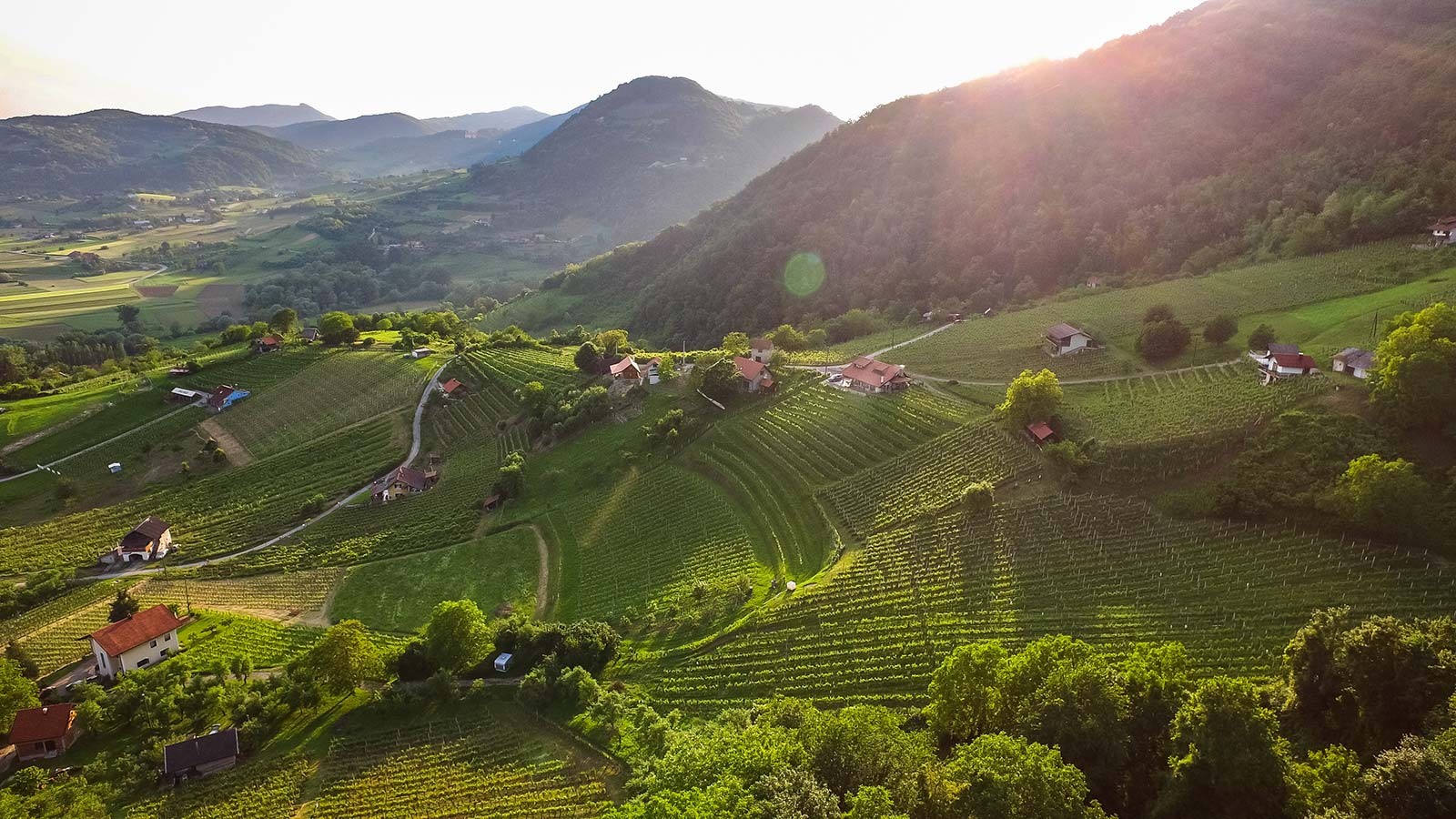 Impossibly pretty Zagorje - the region lies just north of Zagreb and is accessible by continental Croatia trains © Ivo Biocina / Croatia National Tourist Board
Impossibly pretty Zagorje - the region lies just north of Zagreb and is accessible by continental Croatia trains © Ivo Biocina / Croatia National Tourist Board
From the impossibly pretty hills of Zagorje, the peaceful rivers of Karlovac county and the hidden vineyards that surround the capital Zagreb to the vast Pannonian flatlands that stretch to Slavonia, Baranya, Vukovar-Srijem and beyond, the varied topography of continental Croatia is wild, exciting and - by many - wholly undiscovered.
This is land where agriculture and nature thrive side by side, where the stresses of modern-day existence ebb away as you readjust to a way of life that would look mostly familiar to the people who lived here centuries ago. These are places where you can truly be at one with yourself and with your surroundings. In continental Croatia, you often find yourself in an environment that is both timeless and traditional, yet wholly contemporary in regards to its ecological aspirations. And you're never far away from an exciting city environment that you can dip into on a whim – not just Zagreb, but Osijek, Slavonski Brod, Karlovac, Sisak and Varaždin too. To those who really know and love Croatia, Osijek is simply unmissable. It is both the capital of and the doorway to Slavonia and Baranya and should be more accessible by continental Croatia trains. Sadly, international transportation links to the city by air are also quite poor. Improvements in accessibility to Slavonia and Baranya by rail and road are imminent © Romulić & Stojčić
To those who really know and love Croatia, Osijek is simply unmissable. It is both the capital of and the doorway to Slavonia and Baranya and should be more accessible by continental Croatia trains. Sadly, international transportation links to the city by air are also quite poor. Improvements in accessibility to Slavonia and Baranya by rail and road are imminent © Romulić & Stojčić
Unlocking the incredible potential of continental Croatia relies on getting the message out there and facilitating travel to these regions
In recent TCN features we have detailed that motorways within Croatia are among the best in Europe - once you're inside Croatia, travelling by car (or bus) between the regions couldn't be easier. We have also seen evidence of the huge interest in travelling here by rail and using continental Croatia trains.
Of all the modern methods of long-distance travel, rail is by far the most eco-friendly. What better way to begin an environmentally friendly holiday than by arriving on continental Croatia trains? When the country wisely decided to prioritise its internal motorway system, a modern and fast inter-regional rail network was put on the back burner. Nowhere suffers greater from this decision than continental Croatia.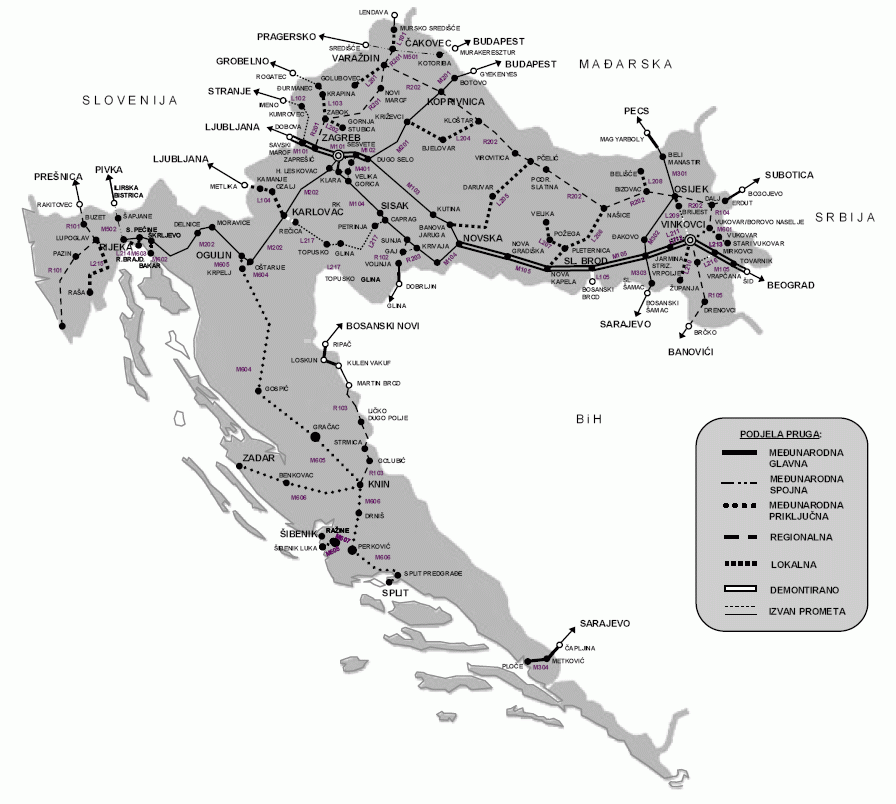 The Croatian rail network © Croatian Official Document uploaded to Wikipedia by Epepe
The Croatian rail network © Croatian Official Document uploaded to Wikipedia by Epepe
The only high-speed line that currently exists in Croatia links Rijeka to Budapest, via Zagreb and Koprivnica. Planned improvements hope to cut journey times between Zagreb and its nearest coastal city to an hour. Same as it ever was - Rijeka was the first Croatian city to be connected internationally by rail. That line also ran into the heart of Austro-Hungary and facilitated upper-class travel to places like Opatija. But does it best benefit the country to invest in more links to the coast or in continental Croatia trains? Well, the inland is not being ignored. Upgrades are being made to continental Croatia trains. This impressive beast actually services the country's coast. But would more investment in the continental Croatia trains network better service more people and help unlock the inland to tourists? Around 70% of the country's inhabitants live in continental Croatia © HŽPP
This impressive beast actually services the country's coast. But would more investment in the continental Croatia trains network better service more people and help unlock the inland to tourists? Around 70% of the country's inhabitants live in continental Croatia © HŽPP
The rail link between Zagreb and Slavonski Brod is so historic that it was once part of the four routes of the Orient Express. It has been maintained to a standard where you can make a relatively quick journey from the capital to Vinkovci via Slavonski Brod. The same cannot be said for rail travel to Osijek, the access point to Baranya and much more. So slow is the connection between Osijek and Zagreb that it has been possible over recent times to reach the Slavonian capital quicker by taking the train to Vinkovci, then the bus to Osijek, rather than travelling direct by rail.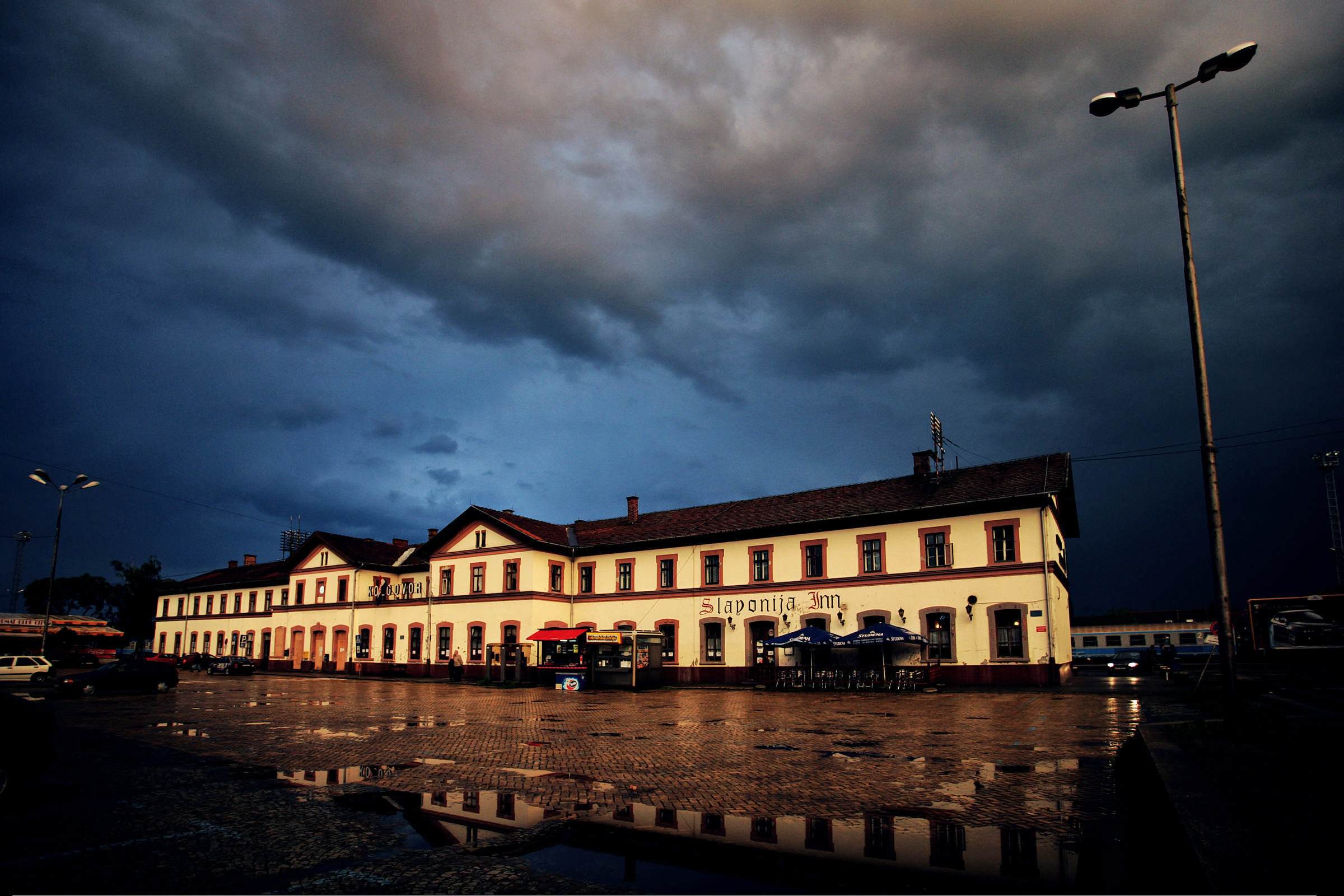 Osijek train station. A renovation to the building is planned for the near future © Romulić & Stojčić
Osijek train station. A renovation to the building is planned for the near future © Romulić & Stojčić
However, in February this year, Croatian Railways introduced four direct daily lines between Slavonski Brod and Osijek. And there will be a new tilting train line that will run between Zagreb to Osijek on Friday afternoon and from Osijek to Zagreb on Sunday afternoon, facilitating student travel. On October 15, the first low-floor train will run between Osijek and Vinkovci as an additional part of the renewal of their continental Croatia trains fleet in Slavonia. The welcome return of Croatia's second-oldest international rail line - linking Osijek to Pécs in Hungary, via Beli Manastir and Baranya - was introduced in late 2018.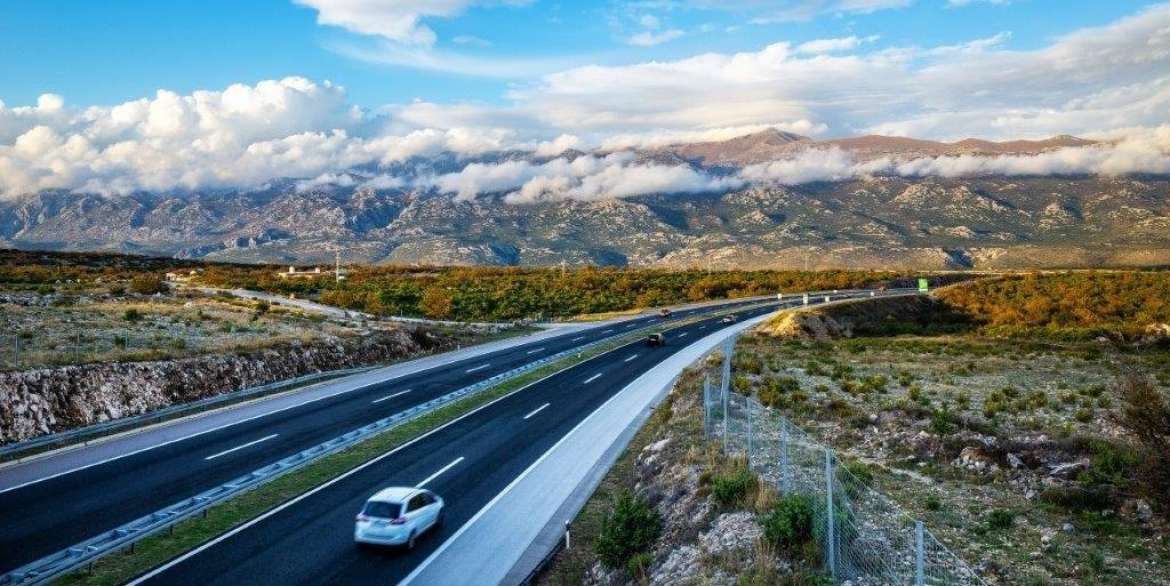 A motorway stretch between Metković and Dubrovnik, integrating the Pelješac bridge and the Croatian segment of the European corridor are the final big remaining projects in a three-decade-long undertaking to give Croatia one of the best motorway networks in Europe. Should Croatia's rail network be next? © Hrvatske Autoceste
A motorway stretch between Metković and Dubrovnik, integrating the Pelješac bridge and the Croatian segment of the European corridor are the final big remaining projects in a three-decade-long undertaking to give Croatia one of the best motorway networks in Europe. Should Croatia's rail network be next? © Hrvatske Autoceste
Access to Slavonia and Baranya will also be massively facilitated upon completion of the European corridor, which will connect North Europe to the Adriatic. Starting in Budapest, it necessitates the building of a bridge near Beli Manastir. Thereafter the motorway will pass by Osijek, connect to the Zagreb-Slavonia motorway near Lipovac, then pass through Bosnia and its capital Sarajevo and on to Ploče.
The removal of budget airline flights to the airport in Osijek remains a hindrance to attracting many international visitors to Slavonia and Baranya. However, with charter airlines facing the greatest uncertainty of all modes of transport at the current time, though their return is a must, it is perhaps now an ambition that should remain more long term. For the immediate future, improvements to rail travel look to be a brilliant way of opening up not only Slavonia, Baranya and Vukovar-Srijem, but also an eco-friendly access point capable of serving the whole of untapped continental Croatia.
For the latest travel info, bookmark our main travel info article, which is updated daily.
Read the Croatian Travel Update in your language - now available in 24 languages
Vukovar Student Becomes Croatia's First Animal Rights Lawyer
October 2, 2020 - Ivana Kramer from Vukovar became Croatia's first animal rights lawyer after graduating from the Faculty Of Law in Osijek
Ivana Kramer from Vukovar has become Croatia's first animal rights lawyer. She did so after graduating from the Faculty Of Law in Osijek, having received her diploma on September 23. The Faculty Of Law in Osijek is the only one in Croatia that has an elective course in animal rights.
In a recent interview with Vecernji List's Suzana Lepan Štefančić, Ivana explained that her desire to become Croatia's first animal rights lawyer stemmed from always having been around animals. “I have three dogs,” she said, in explaining her choice of the elective course in animal rights, “and my mother Željka adopts and helps abandoned animals.”
Some of the animals that Ivana's mum Željka looks after in Vukovar. Photos from the Facebook of Željka Kramer.
Ivana commuted to the Faculty Of Law in Osijek for five years in order to complete the course, choosing to stay living at home in Vukovar rather than move to the Slavonian capital. She says she would ideally like to stay in Vukovar to begin working in this field of law.
Her elective course in animal rights was undertaken in the final year of her studies and was the step that propelled her to the status of Croatia's first animal rights lawyer. During this final year, she researched the Animal Protection Act, which was implemented in 2017, with an emphasis on the situation in the Osijek-Baranja and Vukovar-Srijem counties. Her research included dog shelters in Vukovar and Osijek, where she occasionally volunteers.
For the latest travel info, bookmark our main travel info article, which is updated daily.
Read the Croatian Travel Update in your language - now available in 24 languages


